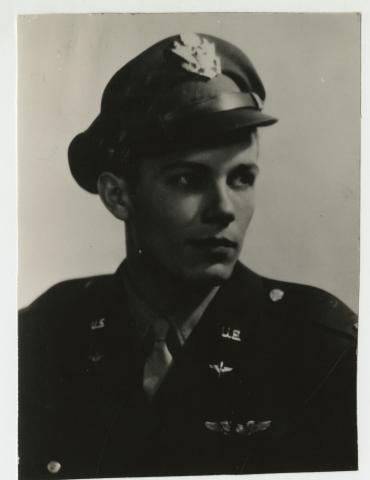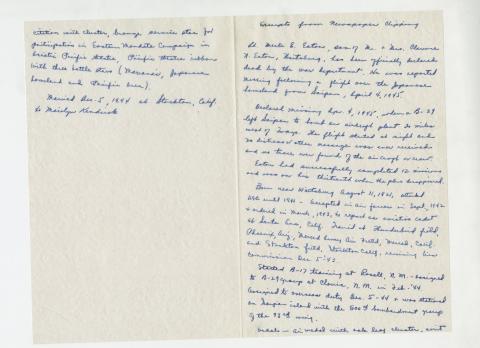Merle Stimmel Eaton
Pre-WSC Life
Merle Stimmel Eaton was born on August 11, 1921 in Waitsburg, Washington to Clarence and Charlotte May Stimmel Eaton. He was the second of three children; he had an older sister, Ursula, and a younger sister, Clara. Eaton graduated from Waitsburg High School in 1940.
Before attending Washington State College (WSC), Eaton worked as a tractor driver. He attended WSC during the 1940-1941 academic year and was a Mechanical Engineering major. He was a member of the Associated Engineers club. After leaving WSC, he worked as a blueprint machine operator at Boeing in Seattle, Washington, then later for Leonard and Slate, a general contracting company in Waitsburg. Eaton married Marily Kendrick in Stockton, California on December 5, 1944. He was a member of the Presbyterian church of Waitsburg, the Masonic lodge of Waitsburg, and he later served as a member of the Maripan Masonic club in the Pacific.
Military Service
Eaton enlisted an an Aviation Cadet in the United States Army Air Corps Reserves in Santa Ana, California on March 12, 1943. He trained at Thunderbird Field in Phoenix, Arizona; Merced Army Air Field in Merced, California; and Stockton Field in Stockton, California. He began B-17 training at Rosell, New Mexico and was assigned to a B-29 group at Clovis, New Mexico in February 1944. He received his commission as a Second Lieutenant, was sent overseas on December 5, 1944 to Saipan with the 500th Bombardment Group of the 73rd Bomb Wing. On the night of April 3-4, 1945, the 73rd Bomb Wing deployed an experimental night bombing attack on the Tachikawa Aircraft Plant near Tokyo, with a secondary target at the city of Kawasaki. Eaton's plane never returned. There was no distress signal sent, and no crash site was ever found. He was declared missing as of April 4, 1945, and declared presumed dead on April 5, 1946.
Burial, Recognition, and Remembrance
Eaton is memorialized at Tablets of the Missing, Honolulu Memorial (Punchbowl) in Honolulu, Hawaii. He was the recipient of the Air Medal; received a unit citation with cluster, and posthumously received a Bronze Star for participation in the Eastern Mandate Campaign in the Asiatic Pacific theatre, and the Pacific theatre ribbon with three battle stars (Marianas, Japanese homeland, and Pacific area).



